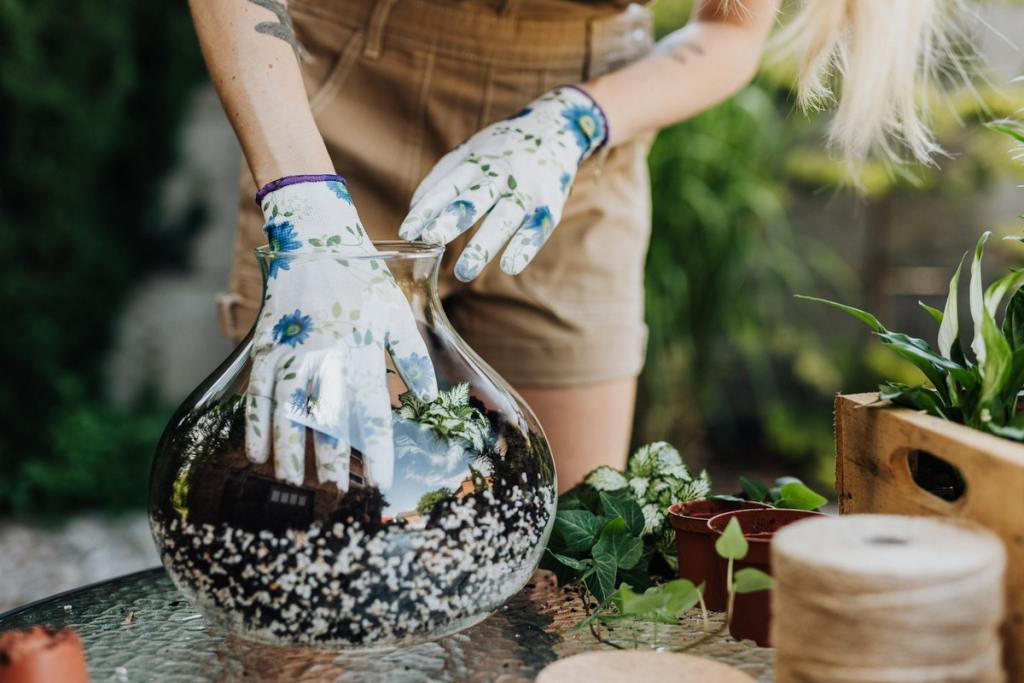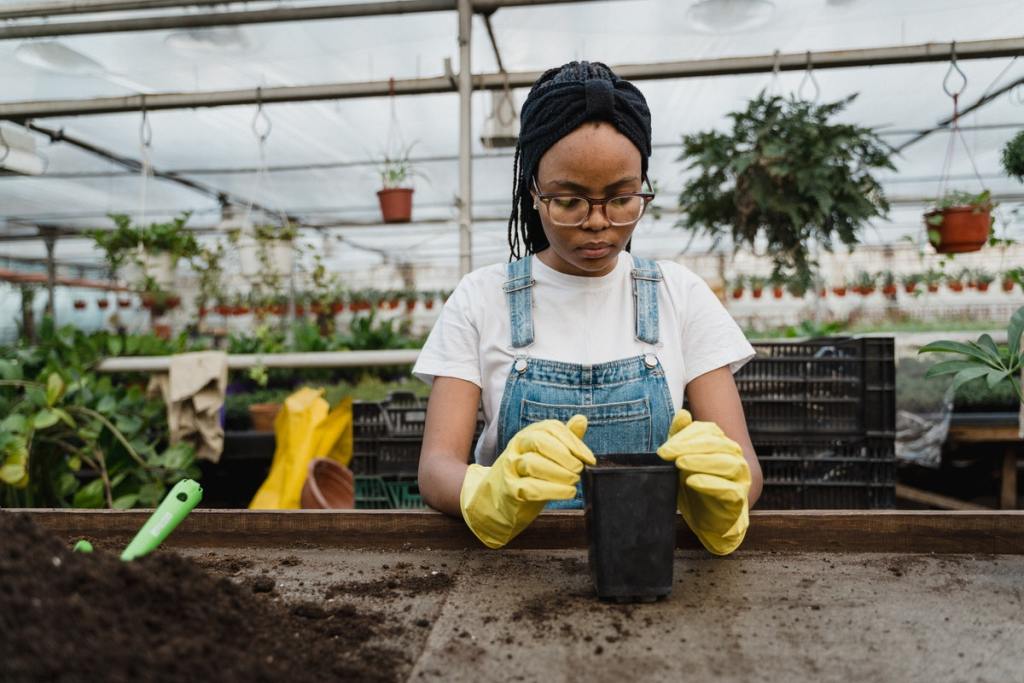Indoor greenhouses: from small tabletop accents to large corner units, you’ve likely seen them making their way around the internet. But how can you get your hands on one? An indoor DIY greenhouse is easier than you think, and it doesn’t have to be too expensive or too involved. There are simple designs using plastic cups and complex designs that recycle old window frames. In the DIY greenhouse world, there’s something for everyone, whether your space is big or small, whether you’re on a budget or have a lot to spend. (And if you don’t have the time for a DIY indoor greenhouse, there are always pre-built ones you can buy!)
Benefits of building an indoor greenhouse
Perhaps the biggest benefit to building an indoor greenhouse is the amount of space it takes up. Whether you don’t have a lot of space in a yard for an outdoor greenhouse, you’re living in an apartment, or you don’t want to invest in maintaining a large outdoor structure, a greenhouse inside is a good alternative. And who doesn’t love a DIY project?
Indoor greenhouses can be an opportunity to show off your style and aesthetic, all while giving your plants a new, safe environment to live in. Other than space-saving, benefits of a DIY greenhouse include:
- Growing veggies out of season
- Controlling the temperature and humidity
- Adding a unique touch to your home
- Being able to move it easily
- Protecting plants from kids and pets

But how easy is it, really?
The ease of your project will depend on the size of your indoor greenhouse. If you want something small that can fit on a table top or plant stand, it’s going to be a lot easier and quicker to do than repurposing a shelving unit. It boils down to how much time and money you have to invest in the project. Like most DIY projects, this one can be made easier by purchasing the materials and products from retail stores; however, you’ll find sometimes it’s more cost effective to play the long game by browsing thrift stores, flea markets, and garage sales.
For those who aren’t as savvy with building, it may be more difficult to put together a DIY greenhouse that repurposes large picture frames or old windows. A lot of the bigger builds require drills, screws, nails, etc., so you may not want to take that on if you have a small space or if the tutorial isn’t too clear. The smaller ones for tabletops are often easier and put together with something like hot glue (a more friendly assembly for those living in an apartment). But you do you! If you find a design you like and have the confidence to take it on or desire to give something new a try, go for it.
If you need some inspiration…
Like most DIY projects, there’s a lot of inspiration online for indoor greenhouses. The most common ones you’ll find often repurpose or upcycle cabinets and photo frames, but don’t be afraid to get creative! These four posts have some good groundwork to get you started, and you may find you have other items lying around your house you can use that aren’t mentioned here.
The IKEA cabinet greenhouse
This DIY cabinet greenhouse repurposes the IKEA Milsbo cabinet, but you can use a similar one instead (like this one on Amazon for around $230).
The person who made this greenhouse also bought a variety of different light fixtures, but you could stick with some simple LED grow light strips from Amazon [link for commerce: https://www.amazon.com/Enfuntins-Spectrum-Dimmable-Gardening-Hydroponics/dp/B08SLTQ6HB/] for $30. Make sure you have the tools on hand to get them outfitted — something to drill a hole in the top, bottom, or side for the power cord to go through. If you want to take it a step further and buy something to monitor the humidity and temperature, you can easily get one for $10.
All-in-all, the project will cost around $300 when you factor in any additional bits and bobs you need or want along the way. If you don’t care about monitoring the humidity, you can cut out the money spent on the gauge. And if you have a location with ample sunlight, there’s really no need for grow lights if you use the cabinet from Amazon. Just consider the fixture you’re working with and how well light can filter through.

The Dollar Store photo frame method
This photo frame indoor greenhouse DIY is perhaps one of the easiest (and cheapest) methods around. You’ll need two 8×10 frames, two 5×7 frames, and two 4×6 frames that, when bought from the dollar store, you could easily budget for under $40. If they don’t come in the color you want, you can pick out a couple small bottles of craft paint (let’s say ~$10 depending on size) and paint brushes (~$5) and re-paint them before assembly.
You’ll also need a hot glue gun and glue sticks ($10 on Amazon for one that comes with the glue!) to put it all together. The cost for this project, on the high end, will be around $80. But if you repurpose some old frames you have lying around — and let’s be honest, you probably already have the glue gun and glue sticks — it could easily be under $50 for the whole shebang.
The indoor greenhouse for kids
If you’re looking for something fun to do with your kids, either on break from school or during the colder months when there aren’t many outdoor activities, an indoor greenhouse project is perfect! This DIY greenhouse is kid-friendly and can be made easily with affordable materials. This tutorial teaches you how to make mini greenhouses with your kids mostly out of plastic cups and tape!
You can get a pack of cups at the grocery store for ~$5 and some scotch tape for ~$2. You’ll need a bag of potting mix, which you can get on Amazon for $5. Pick out the seeds you want to grow and a sharpie or markers you can write on to note which cups contain which plants. Packs of seeds are relatively cheap — 1000 marigold seeds are only $7 on Amazon, but you can grow anything in these mini DIY greenhouses).
All-in-all, this project won’t cost you more than $20-30, and it’s a great bonding experience for you and your kids. Plus, they’ll get to learn about how to take care of plants so they grow big and strong, and that’s pretty cool!
The upcycled curio greenhouse
This DIY curio greenhouse project is rather similar to the IKEA cabinet, albeit more geared towards those who have a decent amount of sunlight in their home and won’t need to drill any holes for grow lights or cables. You can purchase a curio cabinet on Amazon for just over $200 or you can look at your local thrift stores and flea markets to find one a bit cheaper!
Once you have the cabinet, you can design it however you want! What you choose to do and the materials you buy will adjust the cost, but this DIY greenhouse is perfect for people who want one that’s on the larger side but may not be as much of a hassle. You can get a roll of adhesive vinyl on Amazon for $10 and a utility knife for around the same price if you want to cut out your own design.
This project can be anywhere from $50 to $250 depending on the cabinet you choose, the vinyl you decide to go with (pre-cut or not), and whether or not you choose to paint it. More intensive designs will be more of a time commitment, but they’ll look beautiful in the end.
DIY indoor greenhouses are a beautiful way to step up your houseplant game, and you may find yourself with friends and family that ask you to assist with theirs, too! As long as you have the space and time, there’s sure to be a mini-greenhouse that fits within your budget.
Editors' Recommendations
- Easy hoya plants to add to your indoor plant collection
- Here’s how often you should be fertilizing your indoor plants
- Add style to your space with these trendy alocasia indoor plants
- Worried about your sick aloe vera plant? Here’s how to save it
- Growing your own healing aloe plant indoors? Here’s how to care for it



